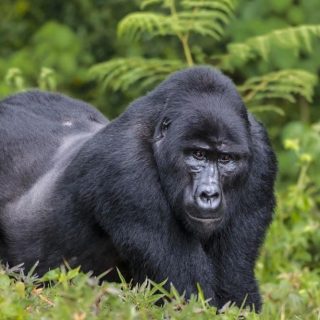Eastern Gorilla. Facts. Habitat. Diet. Lifespan. Population
The Eastern Gorilla Facts, Habitat, Diet, scientific name, Predators, Lifespan, Population, Size, and why are Eastern Gorillas endangered? – The eastern gorilla belongs to the genus gorilla. It is one of the great apes and is very closely related to humans. The eastern gorilla, which is most frequently seen in mountaintop jungles, is known to have numerous characteristics that make it easier for it to thrive in the wild.
Gorilla beringei, a species of eastern gorilla, is considerably more human-like than previously believed and is capable of doing a variety of tasks, including hand-peeling fruits. The eastern mountain gorilla and the eastern lowland gorilla, commonly known as the Grauer’s gorilla, are the two subspecies of the eastern gorilla that exist today.
Eastern Lowland Gorillas
Amazing Facts about Eastern Gorillas
- Male eastern gorillas over the age of 12 begin to transition from black to grey in color, especially on their backs, earning them the nickname “silverbacks.”
- The eastern gorillas have five fingers on each hand and five toes on each foot, just like humans.
- Similar to how a person’s fingerprints can be used to identify them, each eastern gorilla has a unique nose print. It is special, and no two will ever be alike.
- The ears of eastern gorillas are rather small, and they have 32 teeth.
- Eastern gorillas are very intelligent and possess a variety of communication techniques. They converse with one another by making roughly 25 different noises.



Eastern gorilla scientific name
Eastern gorillas are very intelligent and possess a variety of communication techniques. They converse with one another by making roughly 25 different noises.
The tale of Hanno, an adventurer, and navigator who traveled to the coast of West Africa, is where the name “gorilla” originates. The tour participants encountered individuals who were thereafter referred to as “gorillae.” Although it is unknown whether the expedition’s participants came across gorillas, a closer examination of the specimen confirmed Hanno’s description of them, giving the species its name. The male members of the eastern gorilla families are referred to as “silverbacks” as they become older because the fur on their backs gradually turns from black to grey.
Eastern gorilla appearance and behavior
The muscular, sturdy bodies of eastern gorillas are known to be covered with black fur. They have lengthy arms and wide chests. These gorillas’ chests, like their faces, hands, and soles, are substantially less hairy than the rest of their bodies.
The black fur on a male’s back begins to turn gray as he ages. However, the mountain gorilla subspecies has shorter, bluish-tinted fur than the eastern gorillas.
On average, male eastern gorillas are roughly 1.7 meters tall (which is about the same height as the average person). They can, however, occasionally rise to 1.9 meters. The average height of a female Eastern gorilla is only 1.5 meters.
The female eastern gorillas typically weigh around 195-220 lbs., whereas the males often range from 300 to 440 lbs.
Eastern gorillas communicate with each other socially in accordance with the group to which they belong since they live in groups. A silverback male often commands the group, which also includes females and their young. With 35 to 50 members each, groups are frequently connected.
It is known that these gorillas relax for about 40% of the day and engage in activities connected to food for the remaining 30%. The rest of the day is often spent exploring. In their nests, which are sometimes on the ground and sometimes built on trees, they are known to rest and sleep.
